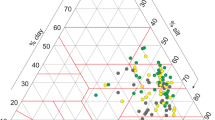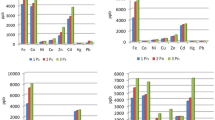Abstract
Current-year, 1-year-old, and 2-year-old needles were collected separately on 37 black spruce (Picea mariana Mill. B.S.P.) trees located on a heavy metal contamination gradient around the smelter in Murdochville, Québec (Canada). Needles were analyzed separately by year for the concentrations of Pb and Cu, a nonessential and an essential metal, respectively. Lead concentrations increased significantly with needle age in the highly contaminated area near the smelter. In contrast, Cu concentrations decreased with needle age in the same area. Our results support the hypothesis that the passive sequestration of toxic metals in the senescing foliage is a detoxification process contrasting with the active translocation of essential metals in the nonsenescent part of the foliage.

Similar content being viewed by others
References
Allard, P., Aiuppa, A., Loyer, H., Carrot, F., Gaudry, A., Pinte, G., et al. (2000). Acid gas and metal emission rates during long-lived basalt degassing at Stromboli volcano. Geophysical Research Letters, 27, 1207–1210. doi:10.1029/1999GL008413.
Ayräs, M., & Kashulina, G. (2000). Regional patterns of element contents in the organic horizon of podzols in the central part of the Barents region (Finland, Norway and Russia) with special reference to heavy metals (Co, Cr, Cu, Fe, Ni, Pb, V, Zn) and sulphur as indicators of airborne pollution. Journal of Geochemical Exploration, 68, 127–144. doi:10.1016/S0375-6742(99)00082-5.
Aznar, J.-C., Richer-Laflèche, M., Bégin, C., & Marion, J. (2007). Mining and smelting activities produce anomalies in tree-growth patterns (Murdochville, Québec). Water, Air, and Soil Pollution, 186, 139–147. doi:10.1007/s11270-007-9472-3.
Aznar, J.-C., Richer-Laflèche, M., & Cluis, D. (2008). Metal contamination in the lichen Alectoria sarmentosa near the copper smelter of Murdochville, Québec. Environmental Pollution, 156, 76–81. doi:10.1016/j.envpol.2007.12.037.
Baker, A. J. M. (1987). Metal tolerance. The New Phytologist, 106, 93–111.
Bindler, R., Korsman, T., Renberg, I., & Högberg, P. (2002). Pre-industrial atmospheric pollution: was it important for the pH of acid-sensitive Swedish lakes? AMBIO: A Journal of the Human Environment, 31, 460–465.
Brackhage, C., & Dudel, E. G. (2002). Long-term differences in transfer and accumulation of potentially toxic trace elements and radionuclides in trees on uranium mining dumps (Erzgebirge, Germany). In B. Merkel, B. Planer-Friedrich, & C. Wolkersdorfer (Eds.), Uranium in the aquatic environment (pp. 513–519). Berlin: Springer.
Brady, K. U., Kruckeberg, A. R., & Bradshaw, H. D. (2005). Evolutionary ecology of plant adaptation to serpentine soils. Annual Review of Ecology and Systematics, 36, 243–266. doi:10.1146/annurev.ecolsys.35.021103.105730.
Chapin, F. S., & Kedrowski, R. A. (1983). Seasonal changes in nitrogen and phosphorus fractions and autumn retranslocation in evergreen and deciduous taiga trees. Ecology, 64, 376–391. doi:10.2307/1937083.
Chiwa, M., Oshiro, N., Miyake, T., Nakatani, N., Kimura, N., Yuhara, T., et al. (2003). Dry deposition washoff and dew on the surfaces of pine foliage on the urban- and mountain-facing sides of Mt. Gokurakuji, western Japan. Atmospheric Environment, 37, 327–337. doi:10.1016/S1352-2310(02)00889-0.
Clemens, S. (2006). Toxic metal accumulation, responses to exposure and mechanisms of tolerance in plants. Biochimie, 88, 1707–1719. doi:10.1016/j.biochi.2006.07.003.
Dahmani-Muller, H., van Oort, F., Gélie, B., & Balabane, M. (2000). Strategies of heavy metal uptake by three plant species growing near a metal smelter. Environmental Pollution, 109, 231–238. doi:10.1016/S0269-7491(99)00262-6.
De Vries, W., Reinds, G. J., van Kerkvoorde, M. S., Hendriks, C. M. A., Leeters, E. E. J. M., Gross, C. P., et al. (2000). Intensive monitoring of forest ecosystems in Europe, 2000. Geneva: UN/ECE.
Dormann, C. F., McPherson, M. J., Araujo, B. M., Bivand, R., Bolliger, J., Carl, G., et al. (2007). Methods to account for spatial autocorrelation in the analysis of species distributional data: a review. Ecography, 30, 609–628. doi:10.1111/j.2007.0906-7590.05171.x.
Environment Canada. (2003). National Air Pollution Surveillance (NAPS) network. Annual data summary for 2002. Environment Canada. http://www.etc-cte.ec.gc.ca.
Fromm, J., Essiamah, S., & Eschrich, W. (1987). Displacement of frequently occurring heavy metals in autumn leaves of beech (Fagus sylvatica). Trees (Berlin), 1, 164–171. doi:10.1007/BF00193559.
Garten, C. T. (1980). Comparative uptake of 234U, 238U, 239Pu, 241Am and 244Cm by boxelder trees (Acer negundo) inhabiting a contaminated Tennessee flood-plain. Health Physics, 39, 332–334.
Goodarzi, F., Sanei, H., Labonte, M., & Duncan, W. F. (2002). Sources of lead and zinc associated with metal smelting activities in the Trail area, British Columbia, Canada. Journal of Environmental Monitoring, 4, 400–407. doi:10.1039/b200787h.
Jansen, S., Broadley, M. R., Robbrecht, E., & Smets, E. (2002). Aluminum hyperaccumulation in Angiosperms: a review of its phylogenetic significance. Botanical Review, 68, 235–269. doi:10.1663/0006-8101(2002)068[0235:AHIAAR]2.0.CO;2.
Klaminder, J., Bindler, R., Emteryd, O., & Renberg, I. (2005). Uptake and recycling of lead by boreal forest plants: Quantitative estimates from a site in northern Sweden. Geochimica et Cosmochimica Acta 69:2485–2496.
Krivan, V., & Schaldach, G. (1986). Untersuchungen zur Probenahme und -vorbehandlung von Baumnadeln zur Element analyse. Fresenius’ Journal of Analytical Chemistry, 324, 158–167. doi:10.1007/BF00473358.
Kuang, Y. W., Wen, D. Z., Zhou, G. Y., & Liu, S. Z. (2007). Distribution of elements in needles of Pinus massoniana (Lamb.) was uneven and affected by needle age. Environmental Pollution, 145, 730–737. doi:10.1016/j.envpol.2006.05.033.
Kurczynska, E. U., Dmuchowski, W., Wloch, W., & Bytnerowicz, A. (1997). The influence of air pollutants on needles and stems of scots pine (Pinus sylvestris L.) trees. Environmental Pollution, 98, 325–334. doi:10.1016/S0269-7491(97)00141-3.
Lamppu, J., & Huttunen, S. (2003). Relations between Scots pine needle element concentrations and decreased needle longevity along pollution gradients. Environmental Pollution, 122, 119–126. doi:10.1016/S0269-7491(02)00274-9.
Lehndorff, E., & Schwark, L. (2007). Accumulation histories of major and trace elements on pine needles in the Cologne Conurbation as function of air quality. Atmospheric Environment, 42, 833–845. doi:10.1016/j.atmosenv.2007.10.025.
Markert, B. (1996). Instrumental element and multi-element analysis of plant samples: methods and applications. Chichester: Wiley.
Marschner, H. (1995). Mineral nutrition of higher plants. Cambridge: Academic.
Martínez-Alonso, C., Valladares, F., Camarero, J. J., López Arias, M., Serrano, M., & Rodríguez, J. A. (2007). The uncoupling of secondary growth, cone and litter production by intradecadal climatic variability in a mediterranean scots pine forest. Forest Ecology and Management, 253, 19–29. doi:10.1016/j.foreco.2007.06.043.
Mingorance, M. D., Valdés, B., & Rossini Oliva, S. (2007). Strategies of heavy metal uptake by plants growing under industrial emissions. Environment International, 33, 514–520. doi:10.1016/j.envint.2007.01.005.
Newhook, R., Hirtle, H., Byrne, K., & Meek, M. E. (2003). Release from copper smelters and refineries and zinc plants in Canada: human health exposure and risk caracterization. The Science of the Total Environment, 301, 23–41. doi:10.1016/S0048-9697(02)00229-2.
Nriagu, J. O. (1994). Global inventory of natural and anthropogenic emissions of trace metals to the atmosphere. Nature, 279, 409–411. doi:10.1038/279409a0.
Pacyna, J. M., & Pacyna, E. G. (2001). An assessment of global and regional emissions of trace metals to the atmosphere from anthropogenic sources worldwide. Environmental Reviews, 9, 269–298. doi:10.1139/er-9-4-269.
Raisanen, M. L., Kashulina, G., & Bogatyrev, I. (1997). Mobility and retention of heavymetal, arsenic and sulphur in podzol at eight locations in northern Finland and Norway and the western half of the Russian Kola Peninsula. Journal of Geochemical Exploration, 59, 175–195. doi:10.1016/S0375-6742(97)00014-9.
Rautio, P., & Huttunen, S. (2003). Total vs. internal element concentrations in Scots pine needles along a sulphur and metal pollution gradient. Environmental Pollution, 122, 273–289. doi:10.1016/S0269-7491(02)00289-0.
Rothpfeffer, C., & Karltun, E. (2007). Inorganic elements in tree compartments of Picea abies. Concentrations versus stem diameter in wood and bark and concentrations in needles and branches. Biomass and Bioenergy, 31, 717–725. doi:10.1016/j.biombioe.2007.06.017.
SAS. (2001). SAS software. Version 8.2. SAS Institute, Cary, NC.
Shotyk, W., & Le Roux, G. (2005). Biogeochemistry and cycling of lead. Metal Ions in Biological Systems, 43, 239–275.
Tervahattu, H., Lodenius, M., & Tulisalo, E. (2001). Effects of the reduction of cement plant pollution on the foliar and bark chemical composition of Scots pine. Boreal Environment Research, 6, 251–259.
Trüby, P. (1995). Distribution patterns of heavy metals in forest trees on contaminated sites in Germany. Angewandte Botanik, 69, 135–139.
Turpeinen, R., Salminen, J., & Kairesalo, T. (2000). Mobility and bioavailability of lead in contaminated boreal forest soil. Environmental Science & Technology, 34, 5152–5156. doi:10.1021/es001200d.
Wyttenbach, A., Bajo, S., Tobler, L., Adam, M., & Zoettl, H. W. (1992). Elemental concentrations in spruce needles: how to obtain and interpret the results. International Symposium on Applications of Isotopes and Radiation in Conservation of the Environment (pp. 535–546). IAEA, Karlsruhe, Germany.
Yoschenko, V. I., Kashparov, V. A., Levchuk, S. E., Glukhovskiy, A. S., Khomutinin, Y. V., Protsak, V. P., et al. (2006). Resuspension and redistribution of radionuclides during grassland and forest fires in the Chernobyl exclusion zone: part II. Modeling the transport process. Journal of Environmental Radioactivity, 87, 260–278. doi:10.1016/j.jenvrad.2005.12.003.
Acknowledgements
We are greatly indebted to M. Aubert, B. Cherbuy, O. Ndzangou, and R. Ouimet for their help during the field work. We also thank R. Rodrigues for the technical assistance and T. Clark for the editing revisions. Funding was provided by the U.S.D.A. Forest Service and the Ministère des Ressources Naturelles et de la Faune du Québec.
Author information
Authors and Affiliations
Corresponding author
Rights and permissions
About this article
Cite this article
Aznar, JC., Richer-Laflèche, M., Bégin, C. et al. Lead Exclusion and Copper Translocation in Black Spruce Needles. Water Air Soil Pollut 203, 139–145 (2009). https://doi.org/10.1007/s11270-009-9997-8
Received:
Accepted:
Published:
Issue Date:
DOI: https://doi.org/10.1007/s11270-009-9997-8




